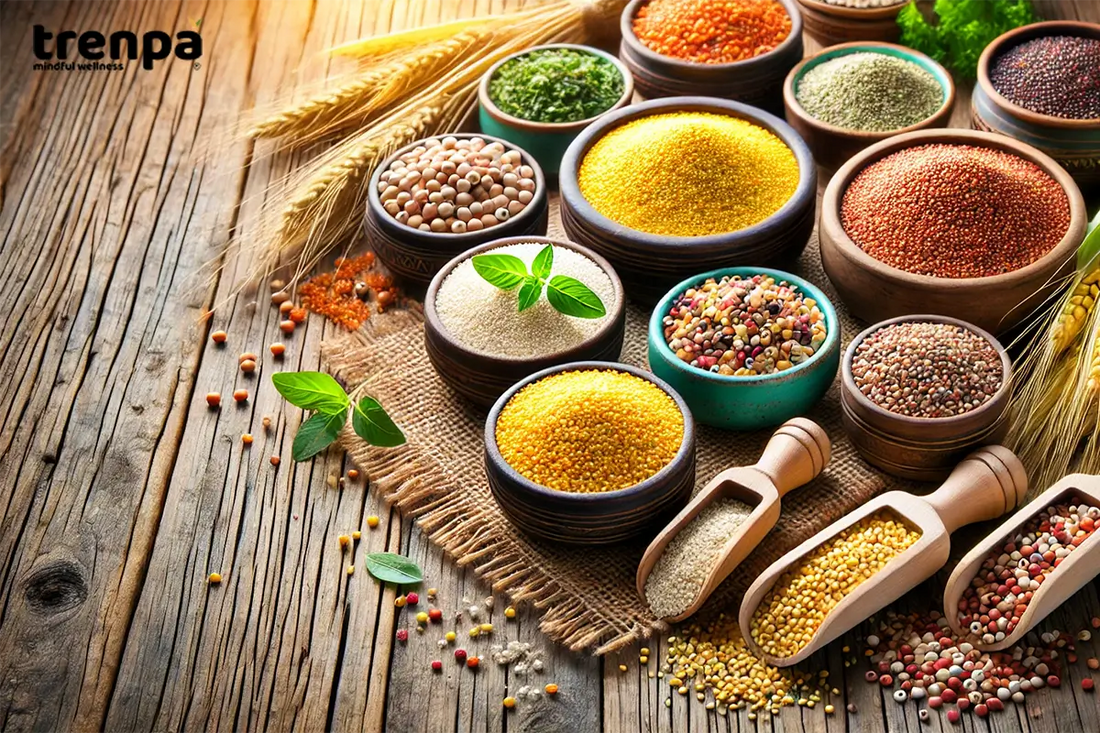
Millets: The superfood you need for weight loss, diabetes, and heart health
Millets are becoming more popular, and for good reason. These tiny grains pack a big punch in terms of health and nutrition. If you are looking for a versatile, healthy addition to your diet, millets could be the answer. In this article, we explore why millets are so beneficial and why they should be a regular part of your meals. Millets for weight loss and health.
What are millets?
Millets are small, round grains that belong to the grass family. They have been grown for thousands of years in Africa and Asia. Unlike wheat or rice, millets are drought-resistant and can grow in tough climates. They come in different types like pearl millet, finger millet, foxtail millet, and barnyard millet. These grains are gluten-free, making them a fantastic option for people with gluten sensitivity.
Millets are also rich in nutrients like protein, fiber, vitamins, and minerals. These grains are often called "superfoods" due to their impressive health benefits.
Health benefits of eating millets for weight loss and health
Rich in nutrients
Millets are loaded with essential nutrients. They contain high amounts of protein, fiber, iron, and magnesium. The protein helps build muscles and repair body tissues. The iron in millets is good for increasing hemoglobin levels. Magnesium is beneficial for your heart health and helps in managing blood pressure. Eating millets regularly gives your body the nutrients it needs to function well.
Aids in digestion
If you have digestive issues, millets can help. They are rich in dietary fiber, which promotes better digestion. Fiber adds bulk to the stool, which makes bowel movements easier. This reduces the chances of constipation. Millets also promote the growth of healthy bacteria in your gut. This helps in keeping your digestive system in good shape.
Helps in weight management
Millets are ideal if you want to manage your weight. They have a low glycemic index (GI), which means they release sugar into the blood slowly. This keeps you full for longer and reduces hunger pangs. When you feel full, you are less likely to snack on unhealthy foods. Including millets in your diet can help you control your calorie intake and manage weight effectively.
Good for eart Health
Millets can keep your heart healthy. They are high in magnesium and potassium, which help regulate blood pressure. They also contain antioxidants that prevent oxidative stress and inflammation. Oxidative stress can lead to heart diseases. By eating millets, you reduce your risk of heart issues like hypertension and atherosclerosis.
Boosts immunity
Eating millets can also boost your immune system. They are rich in antioxidants like phenolic acids and flavonoids. These compounds protect your body from harmful free radicals. Free radicals are unstable molecules that can damage cells and lead to illnesses. Millets also contain zinc, which plays an essential role in strengthening immunity.
Helps manage diabetes
People with diabetes can benefit from including millets in their diets. The low glycemic index of millets ensures that sugar is released slowly into the blood. This helps in maintaining steady blood sugar levels. Finger millet, in particular, is known for its ability to manage diabetes. By replacing high-GI foods with millets, you can keep your blood sugar under control.
Gluten-free option
If you are gluten intolerant, millets are a great substitute for wheat-based foods. They are naturally gluten-free. You can use millets to make porridge, bread, or even dosa. This makes millets an ideal choice for people with celiac disease or those who want to avoid gluten.
How to include millets in your diet
Millets are versatile, and you can include them in your diet in many ways. You can cook them like rice, make porridge, or add them to soups. Millet flour is also great for making flatbreads or pancakes. Here are some simple ideas to get started:
-
Millet Porridge: Cook millets with water or milk, add honey and nuts for a nutritious breakfast.
-
Millet Upma: Substitute rice with millets in your traditional upma recipe for a healthy twist.
-
Millet Flour Bread: Use millet flour to make gluten-free bread or rotis.
-
Salads: Add cooked millets to salads for a wholesome, fiber-rich meal.
-
Millet Khichdi: Replace rice with millets in khichdi for a nutritious lunch option.
Environmental benefits of millets
Millets are not only good for your health but also for the environment. These grains are drought-resistant and need less water compared to other cereals like rice and wheat. They grow well in dry, arid regions where other crops may struggle. By choosing millets, you are also supporting sustainable farming practices and reducing your carbon footprint.
Millets also need fewer pesticides and fertilizers. This means they are a healthier choice for you and the planet. Growing millets helps maintain soil health and biodiversity. They play a crucial role in promoting ecological balance.
Why should you switch to millets?
Switching to millets has multiple benefits for your health, the environment, and even your community. Unlike processed foods, millets are natural and unrefined. This means you get all the nutrients without any chemicals. They help in reducing the risk of chronic diseases and contribute to a healthy diet. Also, millets are easy to prepare and add variety to your meals.
Millets are affordable and accessible. They have been a staple in many countries for centuries, and now their popularity is growing globally. Choosing millets can also support local farmers who grow these ancient grains.
Conclusion: Millets for weight loss and health
Millets are a powerhouse of nutrition. They offer numerous health benefits like aiding digestion, helping in weight management, improving heart health, and managing diabetes. These grains are gluten-free, making them an excellent choice for people with gluten intolerance. Beyond personal health, eating millets also supports sustainable farming and environmental conservation.
Adding millets to your diet is easy and rewarding. Whether you make millet porridge, salads, or flatbreads, you can enjoy the benefits of this superfood every day. Start including millets in your meals and experience the difference they can make to your health and well-being.
Are you ready to give millets a try? Start small by swapping rice or wheat in one meal and see how you feel. Your body and the planet will thank you!
Image Courtesy: ACCENTERRA
Did you find this blog post helpful? Got ideas or questions? Join the conversation below! Your insights could help others too, so don’t hesitate to share!
Please note that all comments will be moderated before being published.
